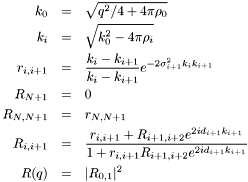| double calcReflectivity | ( | double | q, | |
| double * | a, | |||
| Parratt * | par | |||
| ) |
- Parameters:
-
q The  value to evaluate
value to evaluate  .
. a The set of all adjustable parameters in one array. p The Parratt struct containing all the other information necessary for calculation of  .
.
- Returns:
- The reflectivity
 .
.
calcParratt() .
The instrumental resolution is determined by calculating the reflectivity averaged over several points with Gaussian weights. It's a method that was borrowed and made more general from Parratt32. It works by the following, assuming a  point average,
point average,
![\begin{eqnarray*} R(q) &=& {\sum_{a=-n}^{n} w_a R(q[1+\frac{a}{n}\frac{\delta q}{q}])}/ {\sum_{a=-n}^{n} w_a} \\ \mathrm{or} &=& {\sum_{a=-n}^{n} w_a R(q+\frac{a}{n}\delta q)}/ {\sum_{a=-n}^{n} w_a} \\ w_a &=& \exp\left(-2\left(\frac{a}{n}\right)^2\right) \end{eqnarray*}](form_49.png)
In the first equation, we can specify the instrumental resolution present in the data as in the same manner as it is typically recorded a Chalk River,  . Otherwise, the resolution can be specified as
. Otherwise, the resolution can be specified as  . The Gaussian averaging of points has been pre-calculated for 9 point average. The resolution is held in the struct reservd for unchanging global parameters
. The Gaussian averaging of points has been pre-calculated for 9 point average. The resolution is held in the struct reservd for unchanging global parameterspar->g. If no resolution smearing is required, the method is skipped for speed.
If the surface coverage of the film beign studied is other than 1, than a linear approximation of the coverage can be included in the fit. First, the reflectivity of the bulk/substrate interface is calculated in the same manner as the total film, with the same instrument resolution. If  is the film surface coverage, then the reflectivity is calculated by
is the film surface coverage, then the reflectivity is calculated by
![\[ R(q) = (1-\alpha )R_\mathrm{substrate}(q) + \alpha R_\mathrm{film}(q) \]](form_53.png)
There is no check that the value of  lies between 0 and 1.
lies between 0 and 1.
Finally, the background is added.
00024 { 00025 double tmp, tmp1; 00026 00027 tmp = calcParratt(q, a, par); 00028 00029 /* determine resolution for this q */ 00030 double resolution = par->g.rsn; 00031 if (par->g.rl == ARRAY) 00032 resolution = lookupResolution(q, par); 00033 00034 /* instrument resolution, skip if zero for speed */ 00035 if (resolution != 0.0) 00036 { 00037 00038 if (par->g.rtp == CONSTANT) 00039 { 00040 tmp += 0.882*calcParratt(q+(0.25*resolution), a, par); 00041 tmp += 0.882*calcParratt(q-(0.25*resolution), a, par); 00042 tmp += 0.607*calcParratt(q+(0.50*resolution), a, par); 00043 tmp += 0.607*calcParratt(q-(0.50*resolution), a, par); 00044 tmp += 0.325*calcParratt(q+(0.75*resolution), a, par); 00045 tmp += 0.325*calcParratt(q-(0.75*resolution), a, par); 00046 tmp += 0.135*calcParratt(q+(1.00*resolution), a, par); 00047 tmp += 0.135*calcParratt(q-(1.00*resolution), a, par); 00048 } 00049 else if (par->g.rtp == RELATIVE) 00050 { 00051 tmp += 0.882*calcParratt(q*(1.0+(0.25*resolution)), a, par); 00052 tmp += 0.882*calcParratt(q*(1.0-(0.25*resolution)), a, par); 00053 tmp += 0.607*calcParratt(q*(1.0+(0.50*resolution)), a, par); 00054 tmp += 0.607*calcParratt(q*(1.0-(0.50*resolution)), a, par); 00055 tmp += 0.325*calcParratt(q*(1.0+(0.75*resolution)), a, par); 00056 tmp += 0.325*calcParratt(q*(1.0-(0.75*resolution)), a, par); 00057 tmp += 0.135*calcParratt(q*(1.0+(1.00*resolution)), a, par); 00058 tmp += 0.135*calcParratt(q*(1.0-(1.00*resolution)), a, par); 00059 } 00060 tmp /= (4.898); 00061 } 00062 00063 /* coverage */ 00064 if (a[1] != 1.0) 00065 { 00066 tmp1 = calcNoFilm(q, a, par); 00067 00068 /* instrument resolution, skip if zero for speed */ 00069 if (resolution != 0.0) 00070 { 00071 if (par->g.rtp == CONSTANT) 00072 { 00073 tmp1 += 0.882*calcNoFilm(q+(0.25*resolution), a, par); 00074 tmp1 += 0.882*calcNoFilm(q-(0.25*resolution), a, par); 00075 tmp1 += 0.607*calcNoFilm(q+(0.50*resolution), a, par); 00076 tmp1 += 0.607*calcNoFilm(q-(0.50*resolution), a, par); 00077 tmp1 += 0.325*calcNoFilm(q+(0.75*resolution), a, par); 00078 tmp1 += 0.325*calcNoFilm(q-(0.75*resolution), a, par); 00079 tmp1 += 0.135*calcNoFilm(q+(1.00*resolution), a, par); 00080 tmp1 += 0.135*calcNoFilm(q-(1.00*resolution), a, par); 00081 } 00082 else if (par->g.rtp == RELATIVE) 00083 { 00084 tmp1 += 0.882*calcNoFilm(q*(1.0+(0.25*resolution)), a, par); 00085 tmp1 += 0.882*calcNoFilm(q*(1.0-(0.25*resolution)), a, par); 00086 tmp1 += 0.607*calcNoFilm(q*(1.0+(0.50*resolution)), a, par); 00087 tmp1 += 0.607*calcNoFilm(q*(1.0-(0.50*resolution)), a, par); 00088 tmp1 += 0.325*calcNoFilm(q*(1.0+(0.75*resolution)), a, par); 00089 tmp1 += 0.325*calcNoFilm(q*(1.0-(0.75*resolution)), a, par); 00090 tmp1 += 0.135*calcNoFilm(q*(1.0+(1.00*resolution)), a, par); 00091 tmp1 += 0.135*calcNoFilm(q*(1.0-(1.00*resolution)), a, par); 00092 } 00093 tmp1 /= (4.898); 00094 } 00095 00096 /* coverage */ 00097 tmp = (1.0-a[1])*tmp1 + a[1]*tmp; 00098 } 00099 00100 /* background */ 00101 tmp += (a[0] * 1E-6); 00102 00103 return tmp; 00104 }
 layers, that run from the front layer that the neutrons enter, (
layers, that run from the front layer that the neutrons enter, ( ), to the back, bulk layer, (
), to the back, bulk layer, ( ), reflectivity can be calculated by
), reflectivity can be calculated by
 is
is  , and the Fresnel reflectivity from the interface between layers
, and the Fresnel reflectivity from the interface between layers  is
is  . The reflectivity of the entire system is given by the reflectivity from the top surface, and is shown in the last line above.
. The reflectivity of the entire system is given by the reflectivity from the top surface, and is shown in the last line above. are real valued, and everything else, including
are real valued, and everything else, including  , is complex.
, is complex. . Therefore the parameters (6 for each layer), can be found in the following manner:
. Therefore the parameters (6 for each layer), can be found in the following manner:  1.4.7
1.4.7